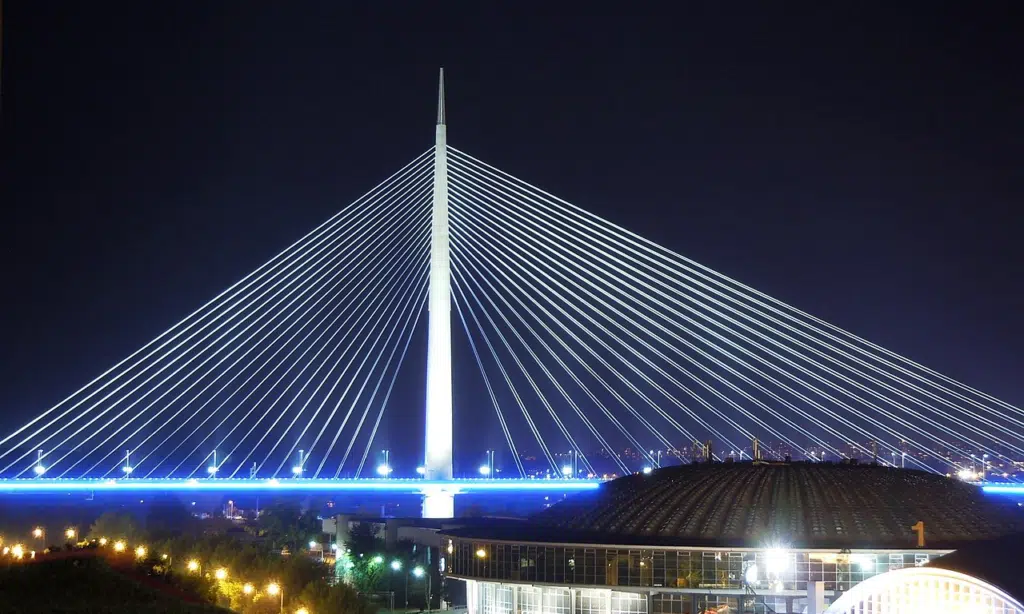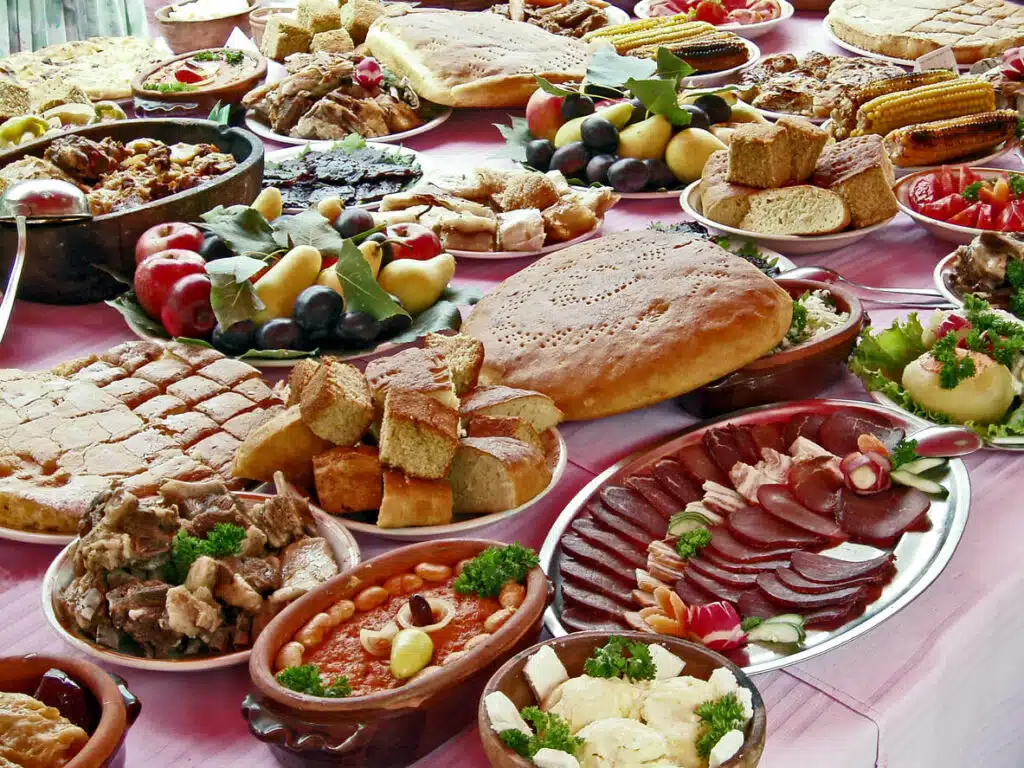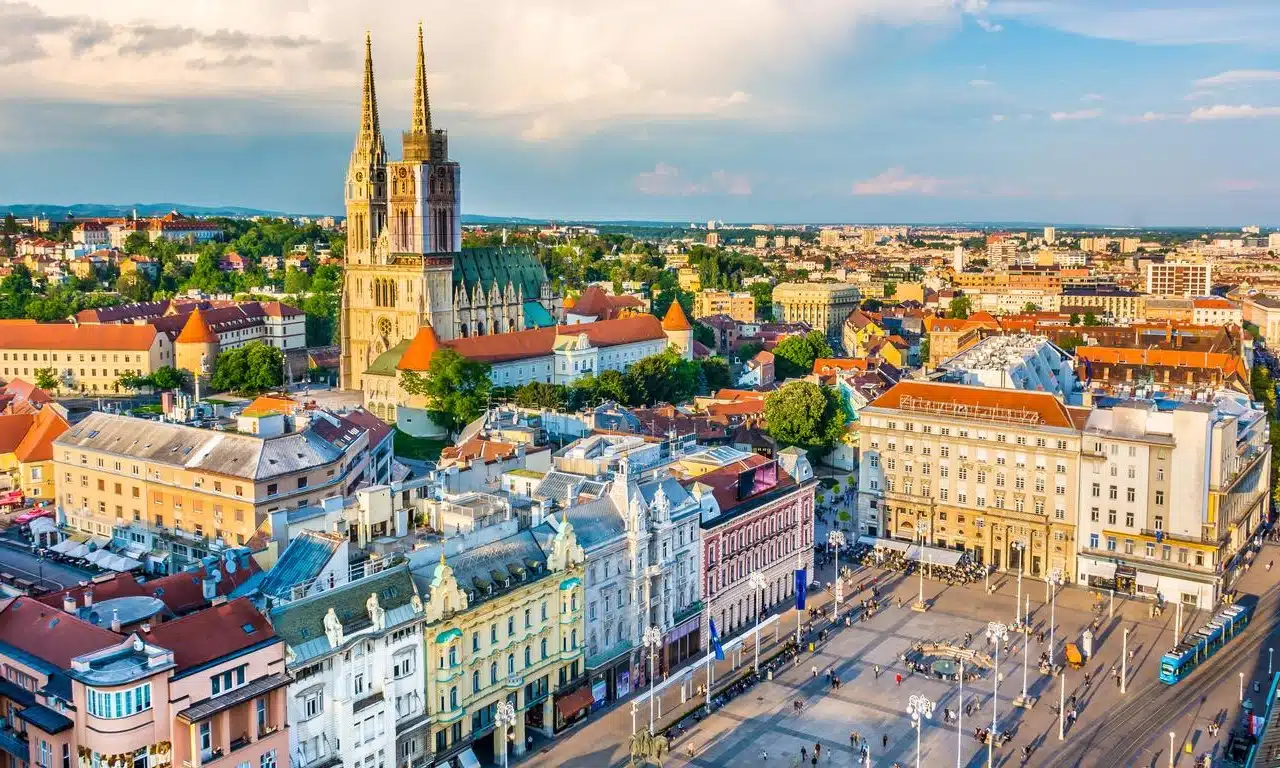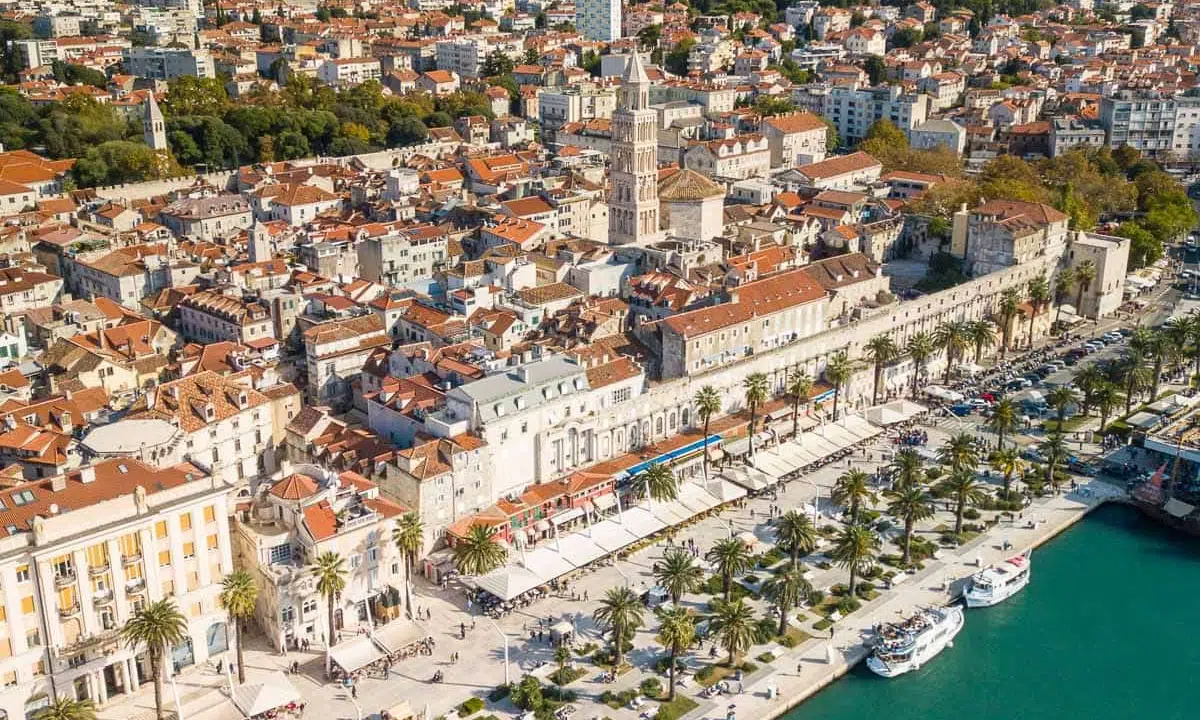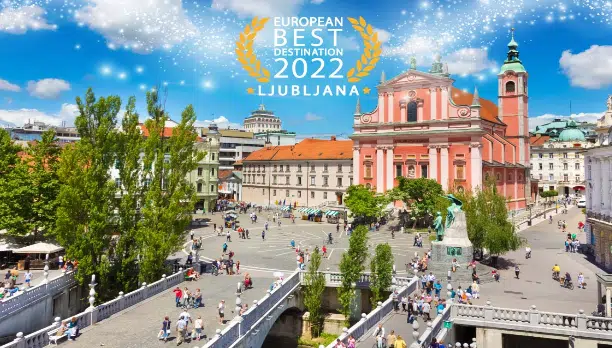Belgrade, the capital city of Serbia, is an exciting destination with a rich history and vibrant culture. Here is our Belgrade guide to help you plan your visit.
Our website includes affiliate links. So, keep in mind that we may receive commissions when you click our links and make purchases. Please read our legal disclaimer document for more information about our Affiliate disclaimer and other disclaimers like Fair-Use disclaimer, etc.
About Belgrade:
Belgrade lies at the place where the Sava joins the Danube. It is one of the oldest cities in Europe and, besides Athens, the most significant urban whole of the Balkan Peninsula. The members of a Celtic tribe founded Singidunum in the third century B.C., while the first record of the name Belgrade dates back to 878 A.D. During its long and turbulent history, 40 armies have conquered the city 38 times. Belgrade is also the capital of Serbia, having around 1.6 million inhabitants.
Furthermore, it is Serbia’s most significant economic hub. Around 30% of the national product of Serbia comes from Belgrade. Belgrade is the capital of Serbian culture, education, and science. It has the greatest concentration of institutions of national importance in science and art. The city is also the seat of the Belgrade University, founded in 1808 as the Great School and the center of the University of Art.
Why is this Belgrade Guide recommending visiting the city in the first place?
Serbia and Belgrade have long been known for their outstanding hospitality and, therefore, rated as one of the most hospitable regions in the world. This high standard of hospitality traces back to the ancient Slavic belief, as they thought the gods wouldn’t favor the host otherwise. So, if you’re looking for a warm and welcoming destination for your next holiday, Serbia and Belgrade are worth considering. Regardless of the package you choose, you can be sure to be welcomed with open arms wherever you go.
How To Get To Belgrade
In this Belgrade Guide, we will try to show you the easiest and the most valuable ways to reach this magnificent city. Owing to its central position and being the former capital of Yugoslavia, the town still keeps its transport links to the surrounding Balkan countries. And that’s why it’s easy to travel here from the rest of the region.
The central Belgrade train station lies on the city’s outskirts. The efficient railway system connects Belgrade to cities domestically and internationally. From here, you can travel by train to Budapest, Ljubljana, Sofia, Zagreb, Vienna, and more.
The bus network is equally as extensive. Long-distance routes connect Belgrade to numerous prominent European capitals, particularly in the Balkans and Eastern Europe, and domestically to towns and other cities across Serbia.
If you need to fly into Belgrade, the Nikola Tesla International Airport has extensive flight schedules across Europe to almost all of the continent’s capital cities. At the same time, flights with Middle Eastern airlines also allow you to connect to much of the world.
Note: If you want to find some valuable flight deals, check the Skyscanner. However, if you’d like to travel by train or bus, we recommend checking the Omio.
How To Get Around Belgrade
Belgrade is a large city with over a million inhabitants, with many suburbs and districts to navigate.
The city operates a network of trolleybuses, trams, and public buses that cover much of Belgrade. Still, you must remember to buy a ticket at the stall before boarding and validate the ticket on the transport.
You can buy one-day or three-day BusPlus Cards, which allow unlimited travel and is an excellent choice for tourists on a short break.
Taxis are plentiful, but be careful when using them and ensure they turn on the meter. Compared to Western European capitals, taxis in Belgrade are excellent value. But if you’d like to learn more, please visit our related article about Taxis in Belgrade.
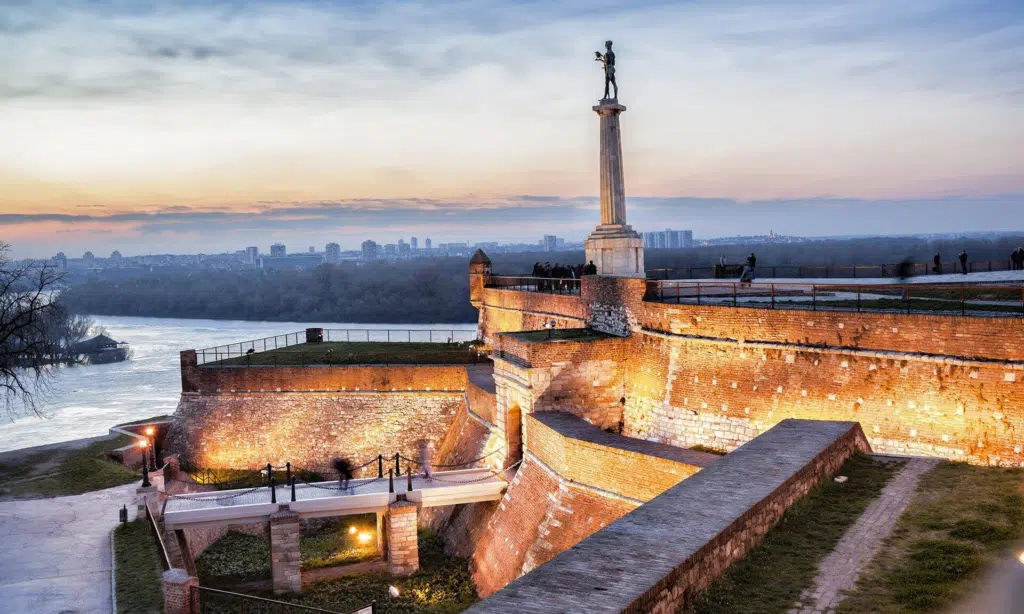
©citycode.rs/belgrade_en.php
Things To Do In Belgrade
The city might surprise you with the number of its attractions despite not being one of the world’s most visited metropolis. That’s why we, in this Belgrade Guide, have decided to share some with you. But if you don’t have much time and want to make the most of it, you can book a tour here.
Kalemegdan Fortress
On top of a cliff overlooking the Danube River, the well-restored Kalmegdan Fortress stretches across a large land area. From the Romans to the 18th century, its crumbling walls have seen everything, from centuries of sieges and battles to several conquests.
The fortress consists of three parts – Upper Town, Lower Town, and Kalemegdan Park, with the latter being a popular space due to its Art Pavilion, various sculptures, and welcoming shade spots. Look around, and you’ll find an abundance of nature, a chess player or two, and couples strolling arm in arm. This dazzling fortress is free to enter and hosts various events throughout the year, from festivals to one-off live music gigs.
Hint: While you are in the fortress, visit Ružica Church. Inside, you’ll find chandeliers made by WWI Serbian soldiers from spent bullet casings, swords, rifles, cannon parts, and numerous frescoes.
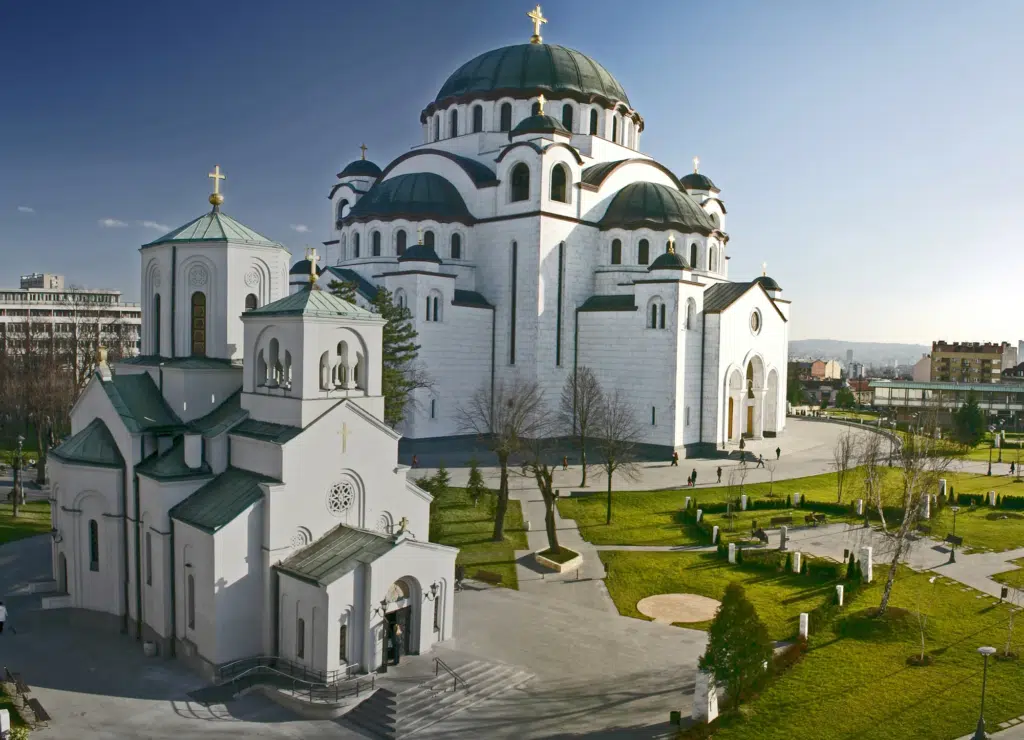
©D. Bosnic/Serbian Tourist Board
Church of St Sava
The largest Orthodox Church in the Balkan region, St. Sava, is an ever-present monument in Serbia’s capital.
That’s why the Church is among the world’s most significant places of worship. Located on top of the Vračar plateau and dedicated to Saint Sava, the founder of the Serbian Orthodox Church, it’s one of Belgrade’s most iconic buildings. You’ll be greeted with glimmering splashes of gold and colorful artwork everywhere you turn.
If you head to the crypt in the basement, you’ll see beautiful frescoes of religious icons and historical figures. Expect to spend 30 to 45 minutes enjoying the impressive décor and architecture. It’s the city’s crowning jewel that sparkles magnificently in the sunshine.

©belgrade-beat.com
Skadarlija
Car-free and paved with bumpy cobblestones, Skadarlija has been a bohemian haunt since the 1800s and is Belgrade’s answer to Montmartre.
Like its Parisian counterpart, Skadarlija’s glory days were in the early 1900s when famous Serbian singers, musicians, writers, and poets lived, worked, and performed here.
That Belle Époque spirit lingers in the iron gaslights, restaurant terraces, foliage, awnings, and the trompe l’oeil facade on the opposing wall.
Come for the cafe’s nightlife and traditional Serbian food like roštilj (grilled meat), and take in the art displays and street performers as you go.
Ada Ciganlija
Ada Ciganlija, an island in the Sava River, has been transformed into a peninsula and is now a popular destination for Belgradians to unwind and engage in outdoor activities. Despite being in the middle of the city, the area has been preserved in its natural state, with a dense forest of mature elm and oak trees.
The Sava River has been dammed on the southern side of the area, creating the lovely Savsko Jezero Lake. During the summer months, Ada Ciganlija is bustling with people who are jogging, rowing, kayaking, playing golf, tennis, basketball, or simply enjoying the greenery.
The pebble beach is the main attraction of Ada Ciganlija, fondly referred to as “Belgrade’s Seaside.” On its coast, you will find many bars and restaurants that offer picnic tables and deckchairs and remain open until late into the night.
Enjoy the Belgrade Nightlife
Belgrade has a thriving clubbing industry that offers more than any other. Visitors often compare it to Ibiza due to its significant club events. Still, the difference is that Belgrade clubs operate year-round compared to Ibiza’s four-month season. The mainstream scene features house, progressive, tech house, and turbo-folk, a sub-genre of folk music with dance and pop elements unique to Serbia. However, venues also specialize in R’n’B, pop, rock, trance, alternative, jazz, and more.
Tip: As a tourist, it’s best to research before visiting a club, including checking the reviews and the reviewer’s background. Belgrade is renowned for its turbo-folk scene, which may need to be more enjoyable for those unfamiliar with the music style from Balkan countries.
Interesting: It is fascinating how Nightlife and Music unite people, once separated by social barriers. The impact of this brotherhood is more evident in foreign countries than in the Balkans.
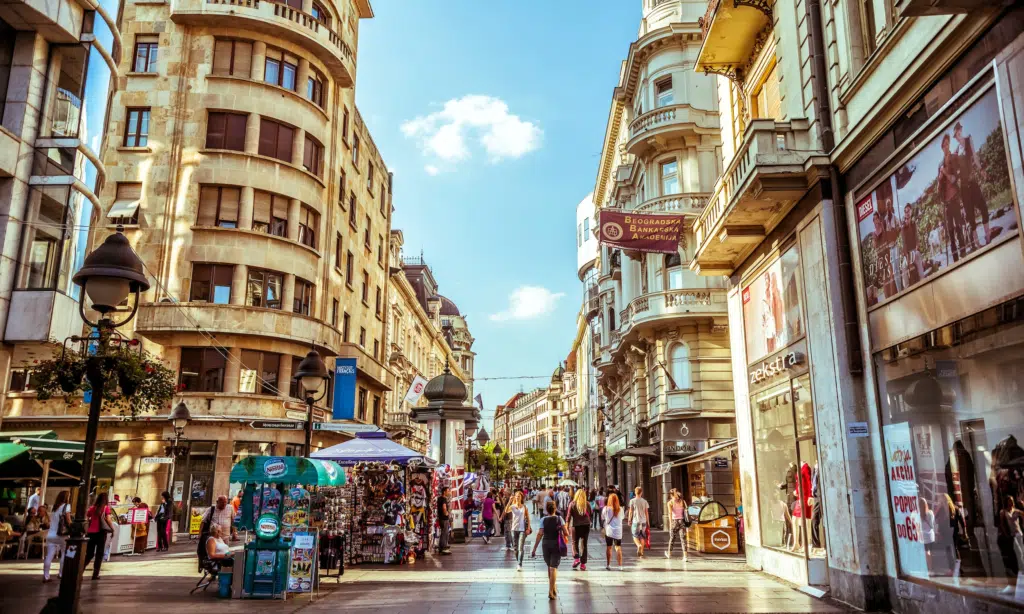
©itinari.com
Have a shopping experience.
Belgrade offers a delightful shopping experience with a mix of traditional and modern Fashion. Check out Knez Mihailova pedestrian zone and Terazije Square for local and international brands. Belgrade Design District features fashionable stores for designer clothing and home decor. Balkanska St. has family-owned craft shops and local products like brandy, wine, and pepper spread. Remember to stop by the Tourist Information Center for souvenirs.
You can also visit some of the biggest Shopping centers in Serbia.
- Usce Shopping Centre is the largest shopping center in Serbia and the region. Its location, close to rivers, and the nature surrounding it, makes it attractive and accessible whether you come from the “old” part of Belgrade or New Belgrade.
- Delta City is the first shopping mall in Belgrade, opened in 2007, and from the opening until today, the number of visitors interested in international and local offers is constant.
- Big Fashion is the biggest shopping center in the old part of Belgrade, opened to the public in April 2017. More importantly, it offers more than 100 shops on two levels with the most famous international and domestic brands, as well as a third level dedicated to dining, relaxation, and entertainment, with a great selection of restaurants, eight cinema halls, a children’s playroom and a beautiful view of the Danube river.
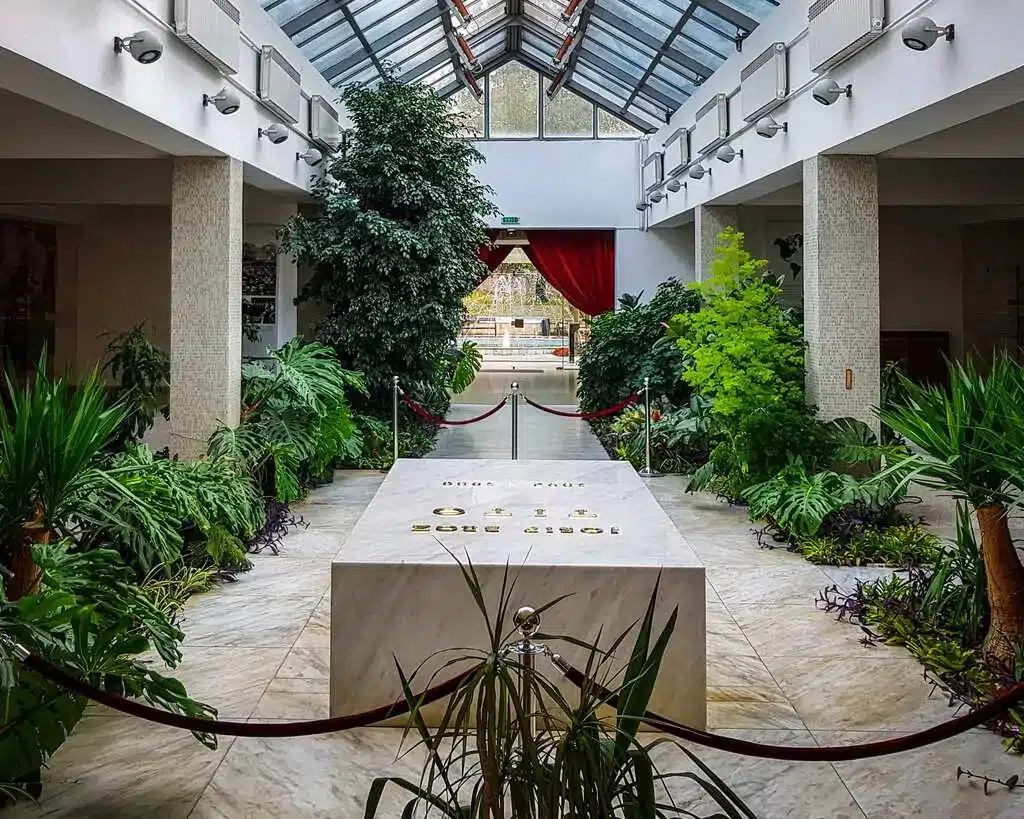
©sofiaadventures.com
Wander through the expansive House of Flowers (Marshal Tito’s Mausoleum)
Visit the final resting place of the President and the First Lady of the former Yugoslavia at the House of Flowers, part of the Museum of the History of Yugoslavia, Josip Broz Tito.
When the president passed in 1980, his resting place was the Flower Shop. However, it was considered rude for the president’s resting place to be called a grave, and with so many people visiting, they changed the name to House of Flowers.
Get amazing views of Belgrade from the terrace. Step inside to view the memorial room, learn more about the president, and check out the May 25th exhibit, the Old Museum, and Tito’s Tomb.
Nikola Tesla Museum
Visit one of Belgrade’s top museums and discover the man featured on the 100RSD note. Experience exciting sci-fi-like interactive elements and unleash your inner nerd. The museum holds Tesla’s ashes in a radiant, golden orb. For years, there has been a debate between the museum, its secular supporters, and the Church regarding whether the remains should be moved to the Sveti Sava Temple.
Step inside the wealthy Stari Dvor and Novi Dvor
The Stari Dvor and Novi Dvor are significant buildings in the city, representing the power of the previous royal families of Serbia.
The Stari Dvor, also known as the Old Palace, was the residence of the Obrenović dynasty, who ruled Serbia for most of the 19th century. However, the monarchy was abolished in 1945. Nowadays, the Old Palace houses the City Assembly of Belgrade and is available for guided tours.
On the other hand, the Novi Dvor, or New Palace, was constructed to serve as the home of the Karađorđević dynasty, the royal family of former Yugoslavia. Presently, the Novi Dvor serves as Serbia’s Presidential Palace, and a one-hour guided tour is available to witness its impressive interiors.
Belgrade Cuisine and Local Food
Belgrade offers a diverse range of traditional Serbian cuisine. Some must-try dishes include Ćevapi (grilled minced meat), Pljeskavica (Serbian-style burger), Sarma, Karađorđeva šnicla (stuffed schnitzel), and Ajvar (red pepper relish). Don’t forget to indulge in Rakija, a strong fruit brandy, and try unique desserts like Burek and Kremšnita.
Taste-test Serbian rakija, and you’re in for a delicious experience!
Note: Belgrade Guide recommends reading a related article if you want to learn more about the best Serbian Food.

©restoranibeograd.com
Get a scenic view of Belgrade at the best rooftop bars.
Belgrade is a city of hedonism, great food, nightlife, and bars where fun is guaranteed. During the peak season, from April to October, the most popular restaurants and bars are those with outside gardens. Some of the Rooftops in Belgrade are pretty much Alternative, and some are High-End based in 5-star Hotels. A common thing for all of them is that you will enjoy the view. So, the best way to observe Belgrade’s skyline is to visit some of the most attractive rooftop bars. We have listed some restaurants offering a spectacular view of the city.
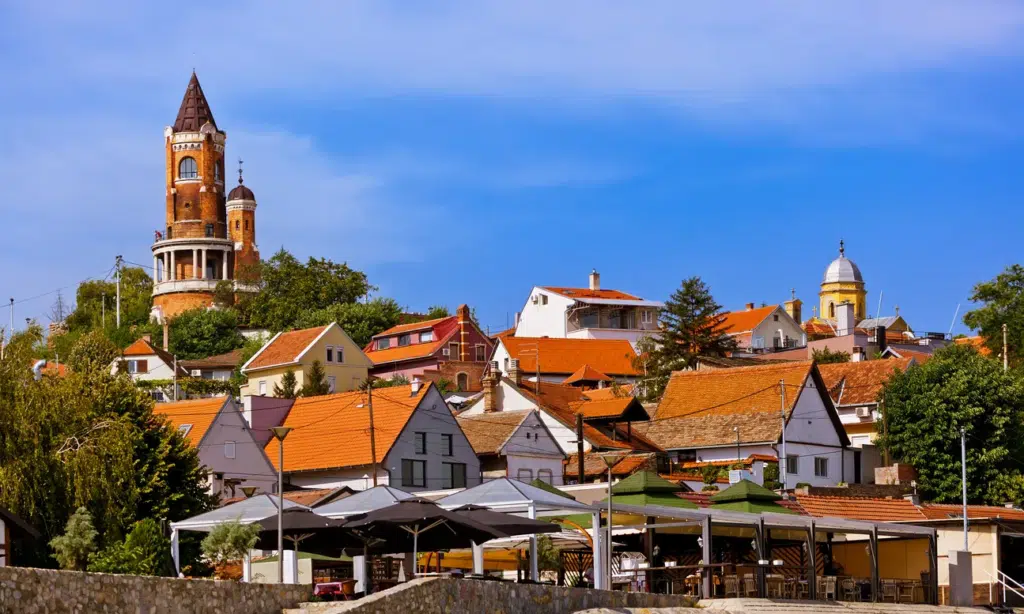
©klook.com
Zemun
Zemun is undoubtedly a city within a city, with its most notable symbol being the Millennium Tower on Gardoš Hill. This Tower of Janos Hunyadi is open daily to visitors. It boasts a balcony that provides an awe-inspiring panoramic city view during bright winter days. Its narrow streets and old Austro-Hungarian buildings in Old Zemun attract visitors, who come to experience the hospitality of its people, authentic cuisine, and cozy atmosphere in its restaurants. For a memorable experience, we highly recommend taking a walk during the day on the always-crowded Zemun promenade along the Danube bank, where you can unwind, indulge in fish specialties, and listen to urban traditional folk music.
City Pass
Belgrade offers the Belgrade City Pass or so-called Belgrade Card, free access to various attractions, and discounts at restaurants, shops, and tourist services. It can be purchased online or at tourist information centers.

©ilovenovisad.com
Best day trips from Belgrade
Novi Sad
Serbia’s second-largest city is located near Fruška Gora National Park. It is famous for being one of the country’s most livable cities. It offers visitors welcoming city parks, a thriving music scene, great art galleries, charming outdoor cafes, and busy bars. Architecture enthusiasts can admire the city’s Serbian and Hungarian architecture, adding to its historical appeal. And if you are interested in taking a tour, you can book it here.
Đerdap National Park
Đerdap National Park is a must-see for travelers exploring Serbia beyond Belgrade. The park follows the Đerdap Gorge, also known as the Iron Gate, for almost 100km, bordering Serbia and Romania. The cliffs that line the valley can reach up to 500m from the river, creating a striking atmosphere. The surrounding terrain consists of mountains, ravines, and lakes, offering visitors an array of panoramic viewpoints.
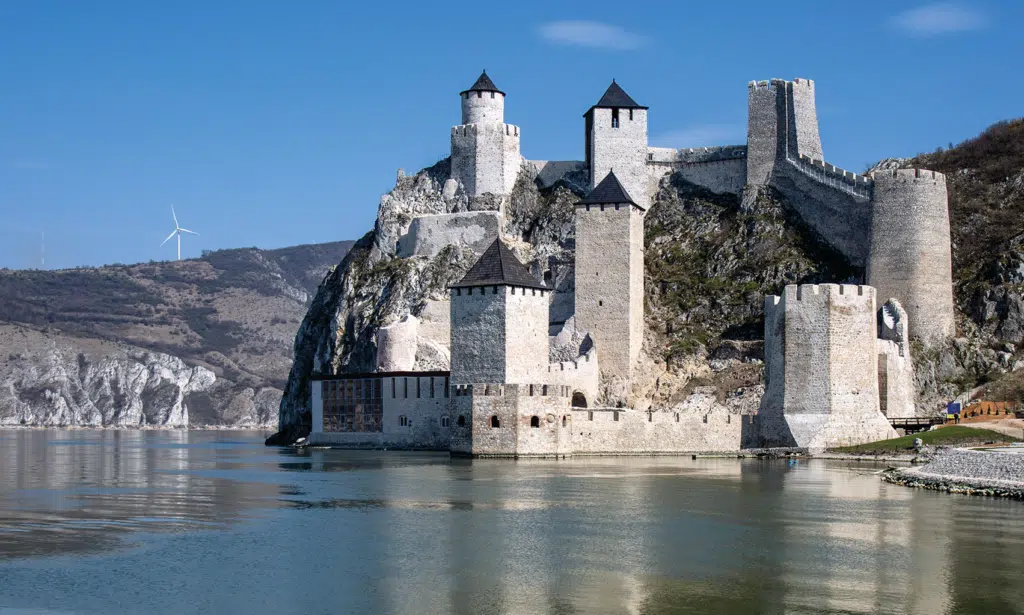
©tvrdjavagolubackigrad.rs
Golubac Fortress
Golubac Fortress, a 14th-century structure, lies on the Danube River in northeastern Serbia. The fortress lies in the Carpathian Mountains’ Iron Gates, where the river is most potent. Over the years, the stronghold has been controlled by different nations, including Hungarians, Austrians, Turks, and Serbs. The Đerdap National Park’s entrance hosts this magnificent fortress renowned for its strategic location and stunning setting.
Smederevo (Fortress)
Smederevo, the former capital of Serbia, boasts a fortified town with an imposing fortress. Built between 1427 and 1430, the Smederevo Fortress is one of the largest in southeastern Europe and a significant military structure. Now an urban park, it features a theater for concerts and festivals. Only 45 kilometers southeast of Belgrade, it’s a popular destination for short excursions.
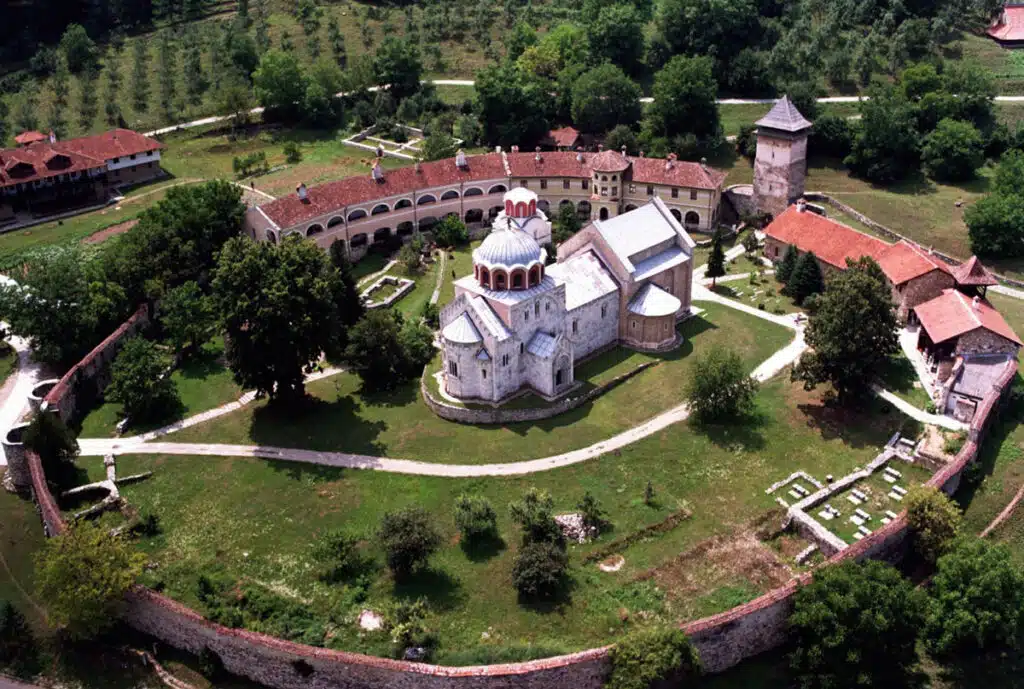
©travelserbiabelgrade.com
Studenica Monastery
Serbia has five UNESCO World Heritage Sites, including the Studenica Monastery. It is the grandest Orthodox monastery in the country and features a complex fortress that dates back to 1190. The monastery was founded by Stevan Nemanja, also known for launching the state of Serbia.
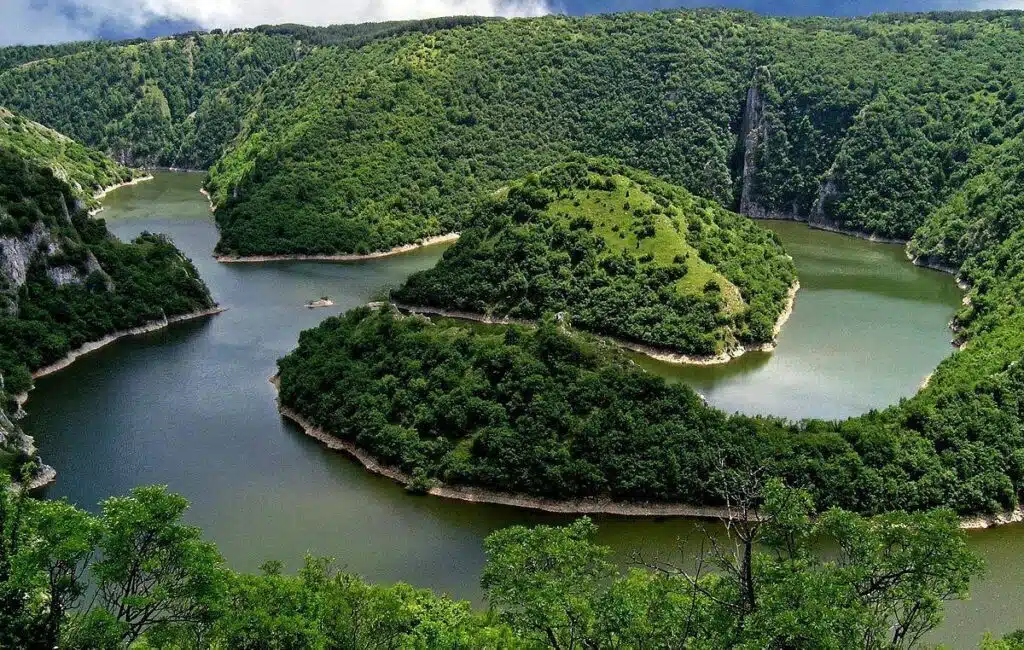
©tripadvisor.com
Uvac Special Nature Reserve
Uvac Special Nature Reserve is a beautiful site near Novi Pazar, Serbia. Highlights of a day trip to Uvac include relaxing on the river, boating, and bird watching. The rare Gryffin Vulture is native to this area. You can reach Uvac from Belgrade by renting a car or joining an organized tour.
The Best Time To Visit Belgrade
When planning a trip to Belgrade, one of your most frequent questions will likely be, “When is the best time to go?” We all have different expectations and desires, so estimating the “best” time to visit the city is complex. Belgrade has a year-round charm; however, some seasons will be more attractive to certain visitors.
The best months to visit are the second half of April, May, June, and September. The weather is just as it should be for a city break: warm, but not hot, dry, and very pleasant, with an average temperature of 18 – 22 C. July and August are also very acceptable, just sometimes it could be boiling. October is usually adorable, but it could be rainy sometimes. October and November were quite pleasant in the last couple of years. December, January, and February are usually cold; New Year’s events on the streets and clubs will warm you up.
Where to stay in Belgrade
Old Town- Where To Stay In Belgrade For First-Timers
If you’re a tourist visiting Belgrade, the ideal location would be in the Belgrade Old Town, also known as “Stari Grad” in Serbian. The area around Republic Square is particularly convenient as it is within walking distance to numerous restaurants, shops, and bars. Additionally, the main sightseeing areas of the city are also easily accessible on foot from this location. To locate Republic Square, search for “Trg Republike” on Google Maps – it’s the central town square in the heart of Belgrade Old Town.
Savamala – the best neighborhood to stay for party life
Suppose you’re into nightlife and alternative culture. In that case, you should check out Savamala, a historically neglected part of town that has been revitalized with many bars and nightclubs. It’s also the location for the Belgrade Waterfront development project, which aims to turn the area into a luxurious residential area filled with skyscrapers. Kosančićev venac is also nearby, a beautiful historic quarter with cobbled streets, museums, coffee houses, and art galleries.
Note: If you want to find the most valuable deals, we recommend using Booking.com.
Stay Safe in the city with our Belgrade Guide.
Belgrade is a safe city, but you should always keep money, mobile phones, travel documents, and other valuable personal items in secure places. Namely, there are pickpocketers in public transportation and other crowded areas, so never wear a backpack or purse on your back, and make sure that you have your wallet in one of your front pockets. If you own a car, it is preferable to have a security system. People usually respect traffic laws, although nervous drivers can change lanes suddenly or make dangerous turns when avoiding traffic during rush hour. So be cautious if you are a pedestrian or riding a bike. Taxi drivers are infamous for swerving in and out of lanes. So, pay close attention to the traffic signals as a pedestrian.
Also, try to avoid getting into conflicts. Suppose you are staying out late in a bar or a club. In that case, there is always a tiny chance that someone will try to pick a fight, especially if you are in a group and a single guy is showing hostility. That is a trap by local hooligans looking for a fight. Just ignore them and walk away no matter what they say or do. The chances that this will happen are small, but stay alert. More importantly, do not try to make fun of the locals in your native language. Almost everyone has at least a basic understanding of English and is familiar with foul words and curses. Generally, common sense is the best way to stay safe in any city in Europe and Belgrade.
Restaurant scams
Suppose you plan on trying out the food scene in Belgrade. In that case, it’s essential to be aware of possible restaurant scams, especially in tourist areas. These scams can include menu changes, higher prices, and pushy promoters.
One of the most common scams is menu switching, where a restaurant presents a different menu with prices higher than advertised. To avoid this, it’s wise to fully understand the pricing structure before ordering. Look for any extra charges or service fees that may apply. You can ensure the pricing process is transparent and fair by asking questions and seeking clarification.
Female solo travelers
Belgrade is generally considered safe for female travelers, and women can confidently explore the city. However, it’s always wise to take certain precautions. Dress modestly and respect local customs to blend in with the local culture. Be cautious when traveling alone at night and consider using reputable transportation options, such as taxis or ride-hailing services. Staying in well-lit and busy areas is advisable, especially after dark. Trusting your instincts and being aware of your surroundings are critical components of staying safe while traveling alone or in a group.
Taxi Scams
Taxi scams can, unfortunately, occur in any major city, including Belgrade. It’s essential to be aware of the potential risks and take precautions to avoid falling victim to such scams. So, it would help if you used reputable taxi companies with a good track record to avoid taxi scams.
Note: if you’d like to know more about taxis in Belgrade, we recommend reading our related article.
LGBT Safety
When visiting Serbia, including Belgrade, LGBTQ travelers need to be cautious, as violence against this population can occur. Public displays of affection between people of the same sex are often met with disapproval. Consequently, verbal abuse and even physical violence are common. While there are gay bars and clubs in the city, it’s essential to exercise caution when arriving or leaving these establishments, as security personnel may be present. Various organizations organize LGBTQ parties periodically, such as Loud and Queer events, so following LGBTQ guides to Belgrade and staying updated on current hotspots can be helpful.
And lastly, if you want to learn more helpful tips about traveling, we recommend reading our Travel resources page.
Other useful information
Visas
A visa is optional for any stay shorter than 90 days. Ensure your passport is valid for at least six months from your planned return date to the country you’re visiting. However, if you need more clarification about your visa status, call www.doyouneedvisa.com, which will let you know whether or not you need a visa based on your nationality and the country you want to see.
Currency
Serbian Dinar (RSD) is the currency in Belgrade. Avoid street money changers and exchange your money at official exchange offices. You’ll find the best rate in the National Bank of Serbia. You can also withdraw RSD at a local ATM.
Avala Mountain is full of WW II monuments—an unmissable part of every Belgrade Guide.
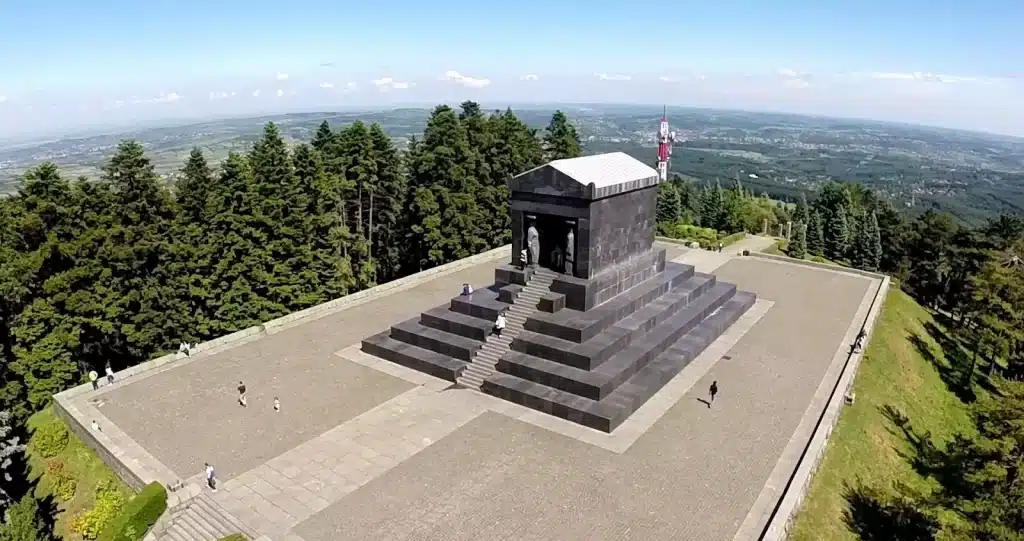
©belgradeatnight.com
Final thoughts
From the impressive Belgrade Fortress to wandering through the city’s cool neighborhoods like Skadarlija and Stari Grad district and learning about the genius Nikola Tesla, the amount of things to do in Belgrade is enough to exceed your expectations!
Which attraction caught your eye the most? Let us know!
Take a look at
Photo credits:
Feature photo credits: ©Wikipedia/Nikola

